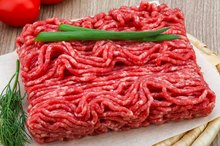Is Ham High in Cholesterol?
Your body makes its own cholesterol, so whenever you eat food high in cholesterol or saturated fat, it adds to your body’s supply. Saturated fat also raises your cholesterol levels. One out of every two Americans has high cholesterol, according to the American Heart Association. Cholesterol and saturated fat come primarily from animal sources, including ham.
Fresh Ham
The most significant difference in the cholesterol content of a fresh, cured ham depends on whether or not you cut away the fat before eating. Most fresh hams have a thick layer of fat that keeps them moist during roasting. If you cut it away before serving, you’ll consume 47 mg of cholesterol per 3-oz. serving, and 4.68 g of saturated fat. If you don’t cut it away, those levels jump to 53 mg of cholesterol and 14.25 g of saturated fat. Hams cut from the leg of the hog are generally higher in cholesterol, with about 80 mg.
- The most significant difference in the cholesterol content of a fresh, cured ham depends on whether or not you cut away the fat before eating.
- If you don’t cut it away, those levels jump to 53 mg of cholesterol and 14.25 g of saturated fat.
Canned Ham
Is Crab Meat High in Cholesterol?
Learn More
Canned hams tend to be leaner than hams purchased fresh, so they have slightly less cholesterol content, about 35 mg per 3-oz. serving. The same size serving also has 7.17 g of fat.
Luncheon Meat
A single slice of “fat free” ham processed as luncheon meat has the least cholesterol content of any ham product. It will still deliver 6 mg of cholesterol to your bloodstream, and another .035 g of saturated fat. A slice of regular luncheon ham has about five times the cholesterol, 32 mg. It also has 4.88 g of fat, a significant difference.
- A single slice of “fat free” ham processed as luncheon meat has the least cholesterol content of any ham product.
- A slice of regular luncheon ham has about five times the cholesterol, 32 mg.
Risks
Nutritional Value for Restaurant Chicken Chimichangas
Learn More
When you eat fats and cholesterol, they don't dissolve in your blood. Your body stores them in lipoproteins, which act as little vessels to carry them through your bloodstream. Low-density lipoproteins, or LDL cholesterol, can join with other fatty substances there and can begin clogging the walls of your arteries. If one of these breaks away from your artery walls, it becomes a blood clot. If the clot prevents your blood from getting to your heart, it can cause a heart attack. If it blocks an artery in your brain or one supplying blood flow to your brain, stroke can result.
- When you eat fats and cholesterol, they don't dissolve in your blood.
- Your body stores them in lipoproteins, which act as little vessels to carry them through your bloodstream.
Suggestions
Because there’s a big difference in cholesterol content between various ham products, you don’t necessarily have to swear off ham for life to protect your health. Low-fat or fat-free luncheon ham can still give you the taste, but without the impact of all that cholesterol. Also avoid eating ham on a regular basis and save it for special occasions.
Related Articles
References
- United States Department of Agriculture: USDA National Nutrient Database for Standard Reference Release 22
- American Heart Association; What Are High Blood Cholesterol and Triglycerides?; 2007 (PDF)
- American Heart Association. What is cholesterol?
- Cleveland Clinic. Cholesterol: What you need to know about high blood cholesterol. May 1, 2019.
- National Center for Health Statistics. Total and high-density lipoprotein cholesterol in adults: United States, 2015–2016. October 2017.
- Centers for Disease Control and Prevention. Cholesterol.
- Barter PJ. The causes and consequences of low levels of high density lipoproteins in patients with diabetes. Diabetes Metab J. 2011;35(2):101-106. doi:10.4093/dmj.2011.35.2.101
- American Heart Association. How to get your cholesterol tested.
- Keene D, Price C, Shun-shin MJ, Francis DP. Effect on cardiovascular risk of high density lipoprotein targeted drug treatments niacin, fibrates, and CETP inhibitors: meta-analysis of randomised controlled trials including 117,411 patients. BMJ. 2014;349:g4379. doi:10.1136/bmj.g4379
- Tall HR, Rader DJ. Trials and tribulations of CETP inhibitors. Circulation Research. Oct. 10, 2017.
- U.S. Food and Drug Administration. Cholesterol: Medicines to help you.
Writer Bio
Beverly Bird has been writing professionally since 1983. She is the author of several novels including the bestselling "Comes the Rain" and "With Every Breath." Bird also has extensive experience as a paralegal, primarily in the areas of divorce and family law, bankruptcy and estate law. She covers many legal topics in her articles.









